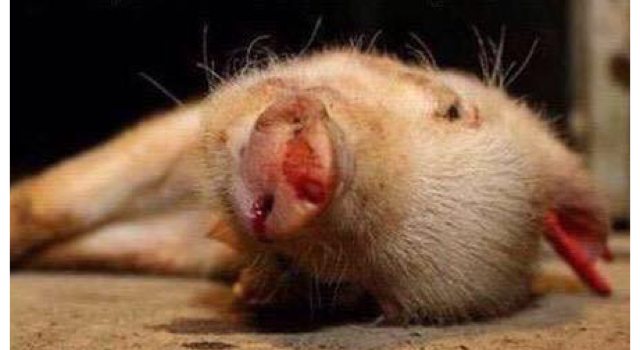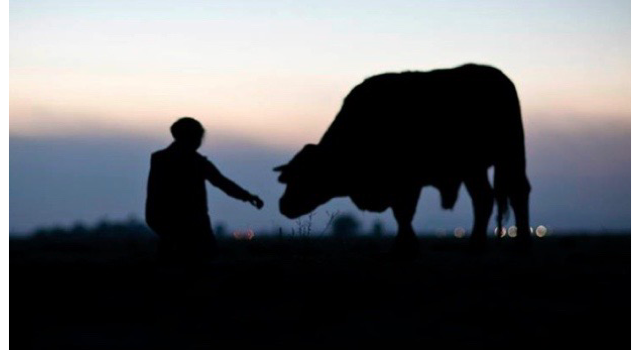Animals In Zoos Are Dying From Bird Flu. Dozens of rare animals including tigers, lions…

The Dairy Industry Is Disgusting, Inhumane And Careless.
The documentary, A Cows Life, which aired on BBC One on Valentine’s Day, saw reporters speaking to vets and farmers about the “controversial” way the milk is flowing.
The report comes as the average daily yield for a dairy cow is 40% higher than it would have been about 30 years ago.
However, in the documentary, a Welsh farm was exposed for animal abuse against its cows, resulting in a dairy boycott.
Footage shows farmers who worked at the facility constantly kicking and hitting an injured cow, with one even hitting it with a shovel.
The footage continues to show another worker aggressively pulling the cow’s tail.
Downton Abbey actor Peter Egan tweeted: “Just watched A CowsLife, the true cost of milk on panorama. Anyone who wants to understand why the dairy industry is disgusting, inhumane and careless should watch it.”
( Jasdip Sensi, 15.02.2022 ) Source: grocerygazette.co.uk
Trophy Hunter Shot Dead In South Africa.
A prolific trophy hunter who slaughtered lions, giraffes and elephants in South Africa has been shot dead at point blank range after his truck broke down.
Riaan Naude, 55, ran the company Pro Hunt Africa which boasts of its ‘eco-hunting’ while sharing gruesome pictures of dead endangered animals.
He was found dead next to his Toyota in Limpopo after pulling it to the side of the road when it overheated.
A witness said two men emerged from a white Nissan, shot him in the head, stole a pistol and then fled.
Naude was discovered along with two hunting rifles, whiskey, clothes, water and pyjamas.
A local cattle herder had heard the single gunshot and then saw the Nissan speeding away towards Marken.
Naude’s company offered hunting safaris in the north of South Africa near Kruger National Park.
A hunter’s day rate costs £250, and customers can enquire for a special rate to hunt the so-called Big Five of lion, leopard, black rhinoceros, African bush elephant and African buffalo.
Other animals offered by Pro Hunt Africa include baboons, hyenas, zebras and warthogs.
Non-profit organisation Protect All Wildlife claimed Naude was involved in breeding and selling giraffes to customers solely for hunting purposes.
( Jack Newman, 04.07.2022 ) Source: dailymail.co.uk
Landowners In Tasmania Allowed To Kill Millions Of Native Animals.
Millions of native animals, including wallabies, green rosellas, cockatoos and wombats have been killed in Tasmania under property protection permits.
In Tasmania, landowners can obtain property protection permits which allow them to kill wildlife to prevent damage to crops, stock or infrastructure.
New data shows 859,304 native animals were killed in 2021 alone and an additional 53,352 were killed up to June 6, 2022.
The total climbs to about 2.8 million when data for 2020 and 2019 is included.
It includes 1,176,002 Bennetts wallabies, 1,088,117 rufous wallabies, 530,487 brushtail possums and 168 common wombats that were recorded as having been killed in the period from 2019 to June 6, 2022.
Other affected species include yellow-tailed black cockatoos, black swans and forester kangaroos (also known as eastern grey kangaroos).
About 3,400 permits for the killing of native wildlife were issued from July 1, 2019 to June 6, 2022.
( Lisa Cox, 02.07.2022 ) Source: theguardian.com
UK Pig Farms Are No Better Than Nations We Regard As Cruel Or Inhumane.
I decided to become a pig vet following many months of labouring on a farm in my teens, and I worked in the sector for four years after qualifying.
I quickly realised after graduating that the farm I worked on as a teenager was actually comparatively good.
I eventually abandoned my career because there was nothing I could do to challenge the system of industry bodies designed to maintain a status quo that was unjustifiably awful.
I could not bear to shoot another pig due to someone else’s lack of care.
Nearly two years on, I am growing tired of receiving appalling footage of the pig industry.
The footage is rightly recognised by the public as “shocking,” but not once have I been shocked by the findings.
I have seen similar atrocities many times in person, and indeed, much worse.
Our patterns of animal use in the UK are not dissimilar to nations we seem to look down on as cruel or inhumane.
We frequently hear the assertion that the UK has some of the best welfare in the world.
I have to burst that bubble.
Not only is the comparison to other nations inaccurate, but it is also largely irrelevant, particularly when you consider that we import 60% of the pig meat consumed here.
Does being better than atrocious automatically make us good?
It certainly does not.
The many unflattering sides to animal agriculture are obscured by industry marketing schemes, paid adverts, and social media bots, all flooding the public sphere with inaccurate, or at best misleading, imagery more palatable to the consumer.
Knowing the reality, it astonishes me how little this is questioned.
( Alice Brough, 17.05.2021 ) Source: sentientmedia.org
UK Duck Farms Are No Better Than Those Exposed In Taiwan And Indonesia.
The vegan organisation Viva! has released footage of a UK duck egg supplier showing the birds kept in dirty conditions tantamount to animal abuse.
The farm investigated is Field Farm, a duck egg supplier in Lincolnshire, England, which produces eggs for Lincolnshire Co-Ops, Noble Foods, and Stonegate, which in turn supply them to major stores such as Tesco, Morrisons, Waitrose and M&S.
Following a tip-off from an ex-worker of the farm, Viva! Campaigns took immediate action and launched an investigation of Field Farm.
Undercover footage, collected between March and May 2022, reveals shocking scenes from inside the farm.
According to Viva!, ducks were found sitting on “decaying” straw, faeces, and urine, and did not have access to water baths.
Viva! posted: “Thousands of sick, lame and dying birds suffer together in barren sheds that create an ideal breeding ground for disease. They are denied access to enough water to dabble or even dip their heads, which is absolute torture for a semi-aquatic animal and exposed to shocking cruelty from workers. This farm must be stopped.”
Lex Rigby, Viva!’s head of investigations, said, “Duck eggs are marketed as a luxury food but the way that these intelligent animals are treated is repulsive – British consumers are being sold a lie. It seems that the UK duck farms are not that different from those exposed in Indonesia and Taiwan a few months ago, which is not surprising because animal abuse is endemic in animal agriculture anywhere in the world.”
( Jordi Casamitjana, 08.07.2022 ) Source: veganfta.com
Chickens And Farm Animals Have Left The River Wye In A Critical State.
A major deal to supply chicken to Tesco from nearly a decade ago may be linked to the ecological demise of one of the UK’s favourite rivers.
As the River Wye flows through mid-Wales to the Severn estuary, it passes through the so-called chicken capital of the UK, where an estimated 20 million birds are farmed in the river’s catchment.
The role of human sewage and wastewater in polluting our rivers has been strongly criticised, but chicken manure from a soaring number of intensive poultry farms plays a huge role too.
Excrement from the birds is rich in phosphates and is spread on the land as a fertiliser to encourage crop growth, but the land can no longer absorb the amount of manure being spread along the Wye, and the run-off is turning the river into what campaigners describe as “pea soup”.
Waste from chickens has been identified by scientists at Lancaster University as one of the largest sources of phosphorus pollution in the Wye catchment, which causes the “pea soup” algal blooms.
The hotspot for chicken farming in the Wye area is Herefordshire, where the numbers of birds began soaring in the early 1990s.
Then, in 2013, a deal to supply extra chicken to Tesco, the UK’s biggest supermarket, was given to Cargill, which owns a major processing plant in the county.
Around the same time, Cargill announced a £35million expansion of its Hereford plant to boost the number of chickens it could process.
There were 22 applications to build intensive poultry units in Herefordshire in 2014 (14 of which were for broiler chickens), leading to an additional 1.4 million birds a year on farms in the county.
Between 2013 and 2017, the number of birds in the county increased by more than one-third, from 13 to 18 million, as the scale of what had already been a hotspot for intensive chicken farming grew even larger.
In May 2022, the UK government rejected a call from MPs and environmental groups for a ban on new and expanding intensive poultry units in the Wye area.
Meanwhile, expansion in the River Wye catchment continues, with intensive poultry units housing an extra 90,000 birds approved by Powys county council in March 2022.
The numbers of chickens and livestock in the Wye area today have left the river in a “critical state”, according to Tim Bailey, a pollution expert at the Environment Agency.
( Nicola Cutcher, Tom Levitt and Robin Eveleigh, 14.07.2022 )
Source: theguardian.com
Australia Has Suffered Catastrophic Losses Of Wildlife And Habitat.
The latest State of the Environment report says Australia has lost the most mammals of any continent.
More than 80% of Australia’s nearly 400 mammal species, from furry greater gliders that fly across tree tops to egg-laying, poisonous platypus, are found nowhere else.
Tragically, the 39 mammal species that have disappeared since colonisation in 1788 represent 38% of the world’s lost mammals.
Since 2016, when the previous State of the Environment was released, 17 mammal species were either added to the endangered list or upgraded to the critically endangered list, as well as 17 birds and 19 frogs.
Prepared by a panel of 32 experts, the government-commissioned State of the Environment report says: “increasing pressures from climate change, habitat loss, invasive species, pollution and resource extraction” have taken their toll on Australia’s deteriorating ecosystems.
Ecologists list land clearing as a top cause of wildlife losses and the State of the Environment report said between 2000 and 2017, there were 7.7 million hectares of land cleared across Australia and 93% of the vegetation was felled without federal approvals for threatened species habitats.
( Mike Foley, 19.07.2022 ) Source: theage.co.au
Thousands Of Cattle Die Due To Hot Weather.
Top U.S. cattle feeding companies sent 1,000-pound carcasses to a Kansas land-fill, where they were flattened by loader machines and mixed with trash, after a June heatwave killed thousands of cows.
Other cattle were buried in unlined graves.
But so many cows died in the unusual heat and humidity that facilities which normally convert carcasses into pet food and fertiliser products were overwhelmed, prompting the state government and cattle feeders to take emergency measures.
The Kansas Department of Health and Environment knew of at least 2,000 cattle deaths due to high temperatures and humidity.
The toll represents facilities that contacted the agency for help disposing of carcasses.
Kansas is the third largest U.S. cattle state behind Texas and Nebraska, with more than 2.4 million cattle in feed-lots.
If farmers were attentive to these animals, providing shade and plenty of water, they would have survived.
( Tom Polansek, 16.06.2022 ) Source: reuters.com
Pigs Are Highly Intelligent.
Non-human animals are constantly proving themselves to be capable of thought, empathy and intelligence in ways that we never expected.
Our new understanding of the minds of animals is fascinating, but these realisations also make it more pressing that we begin re-evaluating our assumptions about what constitutes a person.
Because we are human, it is our own intelligence that we tend to use as a yardstick for measuring the intelligence of other species.
Though many people think that pigs are dirty, lazy and not very smart, the truth is that not only do pigs prefer to be active and clean, they are also highly intelligent.
Four pigs housed at Purdue University’s Center for Animal Welfare Science, named Omelet, Hamlet, Ebony and Ivory, demonstrated the ability of their species to learn by playing a simple video game.
The game consisted of using a joystick to manipulate a dot to hit a blue wall.
After hitting the wall, the pigs received a treat.
All four pigs displayed skill far greater than would be expected by random chance.
In order to play the game, the pigs had to understand that moving the joystick resulted in movement on the screen.
( Grace Hussain, 22.07.2022 ) Source: sentientmedia.org
Animal Agriculture Is The Leading Cause Of Deforestation.
Forests are a critical global resource, covering around 30% of the planet or 4.06 billion hectares.
Increasing rates of deforestation threaten this important resource but also much more — as forests are deeply intertwined with the impacts of climate change, biodiversity and the livelihoods of people who depend on these precious and powerful ecosystems.
Deforestation is the practice of intentionally cutting down trees to clear land for other uses.
In the past 10,000 years, the world has lost 2 billion hectares — or one-third — of its forested land, and half of that has occurred since 1900.
The UN Food and Agriculture Organization (FAO) estimates that an average of 10 million hectares of forest are cut down each year, but some years are much worse than others.
2016 remains the worst year on record for deforestation at 29.7 million hectares, partly due to significant forest fires.
The impacts of deforestation are felt throughout the environment and the natural cycles that regulate life on Earth, as well as in human communities and the animals that depend on forests for habitat.
Trees and natural vegetation help to hold soil in place.
When they are removed, the nutrient-rich topsoil erodes, and is easily washed away in heavy rains or blown away by wind.
Rough, sandy particles that can’t retain water are left behind, making the land unsuitable for growing crops as it eventually turns into a desert.
As forests also regulate the water cycle, clearing them leads to drier local climates, further adding to the risk of desertification.
Forests store huge amounts of carbon, which can be released into the atmosphere when they are cut down.
Deforestation accounts for around 10% of anthropogenic carbon emissions.
Tropical forests are under such severe assault that they have tipped from being a net sink to a net source for carbon emissions, now emitting more than they can store.
Evidence from around the globe shows that deforestation increases the frequency of flooding events as well as making the impacts more severe — increasing the length of floods, the number of people displaced and killed and the physical damage caused.
Various studies have also revealed the different ways that deforestation increases floods.
Deforestation negatively impacts public health in several ways.
Fragmentation of wildlife habitat through forest clearing has increased the spillover of novel pathogens from wildlife to people.
According to the World Wildlife Fund, the loss of forest also risks the loss of potential future medicinal resources.
By contributing to and exacerbating the impacts of climate change, such as floods, deforestation increases the risk of death, particularly for people in parts of the world that are more vulnerable to extreme weather.
When we lose forests, we also lose a source of more direct health benefits such as improved mental and physical well-being and cleaner air.
Forests provide food for millions of people and fuelwood for cooking for 2.4 billion, particularly in developing countries.
By maintaining soil quality, regulating climate and providing habitats and food for a diverse range of species, forests are a critical component of food production beyond their bounds as well.
All of these benefits are threatened by deforestation, which also adds to the pressure on global food supplies due to climate change.
Forests are some of the most diverse ecosystems on Earth, providing homes to trees, plants, animals, insects, microorganisms and carbon-sequestering fungi.
Deforestation fragments and degrades this habitat, reducing or destroying its capacity to support other species.
When their habitat is destroyed, many forest-dwelling species struggle to survive in the pockets of forest that are left.
Smaller areas of habitat can only support smaller populations of a species, reducing their gene pool and leaving them more vulnerable to hunting, poaching and predators.
As some species are unique to specific forest regions, they can easily become extinct when their habitat is destroyed.
Animal agriculture is the leading cause of deforestation.
A massive 41% of tropical deforestation — 2.1 million hectares a year — is directly linked to the expansion of pasture for grazing beef cattle, mostly in Brazil.
In addition, nearly 500,000 hectares of forest is cleared every year to grow soy, the majority of which — around 77% — ends up as livestock feed.
( Claire Hamlett, 05.08.2022 ) Source: sentientmedia.org



This Post Has 0 Comments